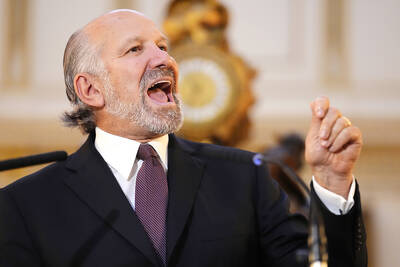Once upon a time, millions of years ago, the humble hedgehog spread over Africa, Asia and Europe, while a freak of nature gave Australia the spiky echidna.
Australia is home to the dianthus erinaceus or hedgehog plant, the chocolate hedgehog cake and the common hedgehog slug, and US porn star Ron "Hedgehog" Jeremy calls Australia home, but the lovable hedgehog is nowhere to be found on the vast continent which was cast adrift at least 200 million years ago.

PHOTO: REUTERS
Curiously, the hedgehog made famous by writer Beatrix Potter and Australia's echidna often fall victim to mistaken identity, along with the spiny porcupine familiar to North Americans.
Yet they are, in fact, one of the world's clearest examples of convergent evolution, say scientists.
Convergent evolution, the emergence of chance look-alikes, involves an evolutionary pattern in which completely unrelated species share similar traits because each has independently adapted to similar ecological and environmental conditions.
"If you were a little animal and you eat insects you have to be on the ground, then one of your main problems in life is that you get eaten by big things, so you have to come up with a defense mechanism," said Erna Walraven, senior curator at Sydney's harborside Taronga Zoo.
"Both hedgehogs and echidnas, independently, have come up with spikes," Walraven said.
The hedgehog is essentially an insect-eating mammal and the porcupine is a large plant-eating rodent, while the echidna is part of an elite group of monotremes -- along with the Australian platypus -- which are a mixture of mammal and reptile.
"If you go back 200 million years ago, you have a number of different animal mammal groups evolving in different spots and in different ways," said Anne Musser, convergent evolution specialist at the Australian Museum.
BREAKUP OF GONDAWANA
About 350 million years ago, Antarctica, India, Australia, Africa and South America formed a single landmass, a southerly "supercontinent" named Gondawana by scientists.
Australia, Antarctica and South America were all joined as East Gondawana before Australia separated and moved north as the landmass broke up, while Antarctica moved south and froze over.
"As Gondawana separated the animals that were marooned were the ones that were able to evolve into what we have now -- marsupials made it south in time to get aboard the ark that was Australia," Musser said.
The hedgehog became part of northern hemisphere history and the American porcupine flourished in its own ark.
While people often refer to Australia's echidna as a cousin of the hedgehog, Taronga Zoo's Walraven said hedgehogs and echidnas were as far removed from each other as they could be.
The reproductive system is what typifies the difference.
The echidna, a monotreme, has a pouch, lays eggs and then suckles its young. The hedgehog gives birth to "hoglets", usually four to six offspring at a time. Their tiny spines are covered with a membrane which shrivels away and hardens within hours.
The young echidna hatches after about 10 days incubation and will then remain in its mother's pouch for seven to eight weeks. During this time it gradually becomes spiky.
There are many species of hedgehogs, given their almost global distribution, but the one most commonly referred to -- and fictionalized by children's writer Beatrix Potter with her Mrs. Tiggy-Winkle hedgehog character -- is the erinaceus europaeus.
Hedgehogs are usually brown and yellow and have an immensely developed stomach muscle which allows them to curl up into a ball for protection when they are frightened. It eats bugs and berries and has a penchant for slugs, bird eggs and snakes.
Australia's echidna is about 40-55cm long, the erinaceus europaeus hedgehog is 20-25cm long with a round body, stiff spines and a hairy underbelly.
The echidna, one of the oldest unchanged creatures in the world, likes to live in the bush and comes out at night to eat ants and termites with its sticky tongue.
There are more than a dozen species of hedgehog found throughout Africa, Asia and Europe, including the British Isles, where they feast on the eggs of now endangered birds.
The American porcupine, about 75cm long when fully grown, has quills protecting its back, sides and tail, which usually lie flat against its body until the animal is faced with danger.

In recent weeks the Trump Administration has been demanding that Taiwan transfer half of its chip manufacturing to the US. In an interview with NewsNation, US Secretary of Commerce Howard Lutnick said that the US would need 50 percent of domestic chip production to protect Taiwan. He stated, discussing Taiwan’s chip production: “My argument to them was, well, if you have 95 percent, how am I gonna get it to protect you? You’re going to put it on a plane? You’re going to put it on a boat?” The stench of the Trump Administration’s mafia-style notions of “protection” was strong

Every now and then, it’s nice to just point somewhere on a map and head out with no plan. In Taiwan, where convenience reigns, food options are plentiful and people are generally friendly and helpful, this type of trip is that much easier to pull off. One day last November, a spur-of-the-moment day hike in the hills of Chiayi County turned into a surprisingly memorable experience that impressed on me once again how fortunate we all are to call this island home. The scenery I walked through that day — a mix of forest and farms reaching up into the clouds

With one week left until election day, the drama is high in the race for the Chinese Nationalist Party (KMT) chair. The race is still potentially wide open between the three frontrunners. The most accurate poll is done by Apollo Survey & Research Co (艾普羅民調公司), which was conducted a week and a half ago with two-thirds of the respondents party members, who are the only ones eligible to vote. For details on the candidates, check the Oct. 4 edition of this column, “A look at the KMT chair candidates” on page 12. The popular frontrunner was 56-year-old Cheng Li-wun (鄭麗文)

“Eighteen years ago, people didn’t even know the name of this ingredient,” says 58-year-old Gil Sa-hyeon, holding up a cluster of dried brownish stems. “Now it’s everywhere.” His shop, Joseon Yakcho, sits in the heart of Seoul’s Yangnyeongsi Market, South Korea’s largest traditional medicinal herb market, its streets lined with shops displaying buckets of herbs such as licorice root and cinnamon bark that spill on to the pavements, filling the air with their distinct, earthy aroma. The ingredient Gil is referring to is hovenia dulcis, known in Korean as heotgae — the oriental raisin tree that’s become the cornerstone of South Korea’s